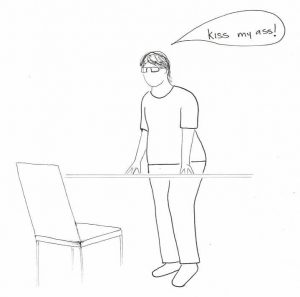The set & props at work in the workshops
The primary role of some elements of the set is practical. They serve the play by orienting the performers and audience to the world of the play’s characters, as is the case with the three signs from We Need to Talk! that indicate the names of the social service agencies. The ‘Waiting Room’ area serves a dual purpose. In addition to orienting the audience to what the space represents, it’s a visual reminder throughout the play of how much time people who are accessing social services have to spend waiting.
Other objects have a more meaningful and evocative role. For example, the empty chairs and the rocks were integral not only during the performance itself, but also in how they contributed to the performance creation process. The empty chairs from We Need to Talk! entered the process early. In our first workshop with participants we did an activity called ‘Talk to the Chair.’ Participants were invited to speak to an empty chair while imagining they were trying to access needed services.
“Transforming Stories actually helped us to tell exactly what we wanted to say… instead of saying what they wanted to hear.” — performer-advocate, We Need to Talk!When the women first approached the chairs, they said the kinds of things that they felt like they needed to say. They were polite and careful not to offend. When they were invited to repeat the exercise, this time saying what they really wanted to say, not what they thought service providers wanted to hear, the group responded with enthusiasm.
Below is a small sampling of some of their statements:



At the time of the exercise we had no idea that the empty chairs would become part of the final performance and that the activity of speaking to them would generate large portions of the play’s dialogue. Devising a performance like this is a process of experimentation. Some things click, others don’t. The chairs clicked, but they weren’t enough.
As we listened to what workshop participants were saying, both during the theatre exercises and in the group reflections, it became clear that they were dealing with multiple issues and that each issue demanded a lot of their time and energy to figure out how to access the resources they needed (housing, health care, food, and so on). We felt that telling the story of what it was like going to your caseworker or to a food bank receptionist and not getting what you need, wasn’t fully capturing the reasons for the women’s frustration. We needed something to convey how overburdened they were. We needed some way to show what they were carrying. This is where the rocks came in.
After many conversations about what was needed, Melanie (our set and prop designer and co-facilitator of the workshops), made a bunch of ‘rocks’ out of rolled up newspaper and masking tape and brought them to the next workshop. We invited participants to repeat the activity of approaching the different agencies and speaking to the chair, but this time to do it carrying an armload of the newspaper rocks. Everyone loved the rocks! We later added the scene where each performer introduced their character. This allowed them to attribute more specific meanings and histories to the rocks they carried with them throughout the play.

